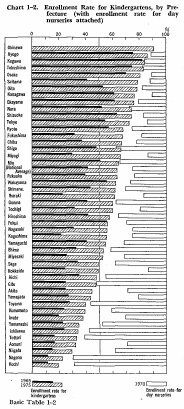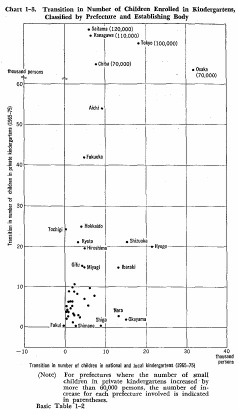| Home > Policy > White Paper, Notice, Announcement > White Paper > EDUCATIONAL STANDARDS IN JAPAN 1975 > CHAPTER1 1 (2) | ||
The percentage of childrens' enrollment in kindergartens (the pro-portion of first graders in elementary schools finishing kindergarten education) in each prefecture in 1965 and 1975, and that of day nurseries (the proportion of first graders in elementary schools who had attended day nurseries for one pre-school year) in each prefecture in 1970 are shown together graphically in Chart 1-2.


It indicates that there was a wide prefectural gap in 1975 in the enrollment rate for kindergartens, which ranged from a high of 91.3% in Okinawa Prefecture to a low of 19.4% in Kochi Prefecture. The enrollment growth rate for kindergatens from 1965 to 75 averaged 22% for the nation, but differed considerably according to prefecture. For example, the enrollment rate advanced by more than 30% during this period in the five prefectures of Ibaraki, Fukushima, Miyagi, Saitama and Kagoshima, but showed little change in the two prefectures of Fukui and Kagawa. It is necessary to consider the enrollment rate for kindergartens in each prefecture and its transition in relation to that for day nurseries. As is indicated in Chart 1-2, the enrollment rate for day nurseries is low in the prefectures where that for kindergartens is high, but is high in the prefectures where that for kindergartens is low. It implies that kindergartens and day nurseries are playing a mutually complementary role. Accordingly, if both of these two types of institutions are taken into account, it is evident that pre-school education has spread rapidly.
The degree to which kindergarten education has spread in each prefecture is shown in Chart 1-3 on the basis of increase or decrease during 1965-75 in the number of children enrolled in national, local and private kindergartens. It indicates that the pattern of increase in enrollment in those kindergartens differs to a fair extent according to prefecture. That is, while growth of enrollment in private kindergartens is high in the prefectures in which big cities are located and their peripheral prefectures such as Saitama, Kanagawa, Tokyo, Chiba, Osaka, Aichi, Fukuoka, etc., that of enrollment in national and local kindergartens is large in such prefectures as Nara, Okayama, Shiga, etc. In such prefectures as Ibaraki, Hyogo, Shizuoka, etc., the increase in the number of enrollment in national and local kindergartens is nearly the same as that in private kindergartens.
| Back to Top | MEXT HOME |